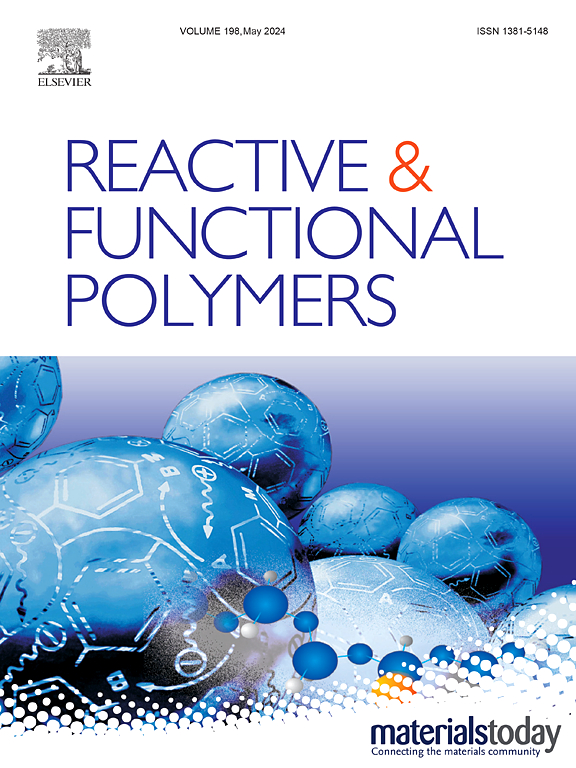金属离子(Ce3+, K+, Zr4+)改性聚硅氧烷流体的热稳定性及其在热界面材料中的应用
IF 5.1
3区 工程技术
Q1 CHEMISTRY, APPLIED
引用次数: 0
摘要
采用K+、Ce3+和Zr4+离子对聚二甲基硅氧烷(PDMS)进行高温热共混改性,合成了含金属的聚硅氧烷流体。通过29Si NMR, FT-IR, XPS和TGA对其结构进行了表征,证实了改性成功。系统的研究表明,金属的种类、含量和混合温度对热稳定性和导电性有重要影响。值得注意的是,Ce3+修饰的PDMS表现出增强的性能:加入2 wt%硬脂酸铈使PDMS的固有导热系数提高到0.203 W/(m·K)(比纯PDMS高13.4%),同时在1 kHz时显著降低介电常数从2.67降至2.56,介电损耗从0.0060降至0.0025。进一步的应用研究表明,铝填充复合材料的导热性能得到了显著改善。以Ce3+修饰的PDMS为基体,α-三甲基硅氧基-ω-三乙氧基硅氧基末端的PDMS为氧化铝表面处理剂(负载量为86 vol%),得到的硅浆料达到6.84 W/(m·K),比纯PDMS提高38.2倍。以α-二甲基乙烯基硅氧基端基PDMS为表面处理剂的类似配方,得到了6.62 W/(m·K),提高了37.0倍。热耗散实验验证了这些复合材料的优越性能,突出了它们在先进热管理应用中的潜力。本文章由计算机程序翻译,如有差异,请以英文原文为准。

Thermal stabilities of polysiloxane fluids modified by metal ions (Ce3+, K+, Zr4+) and their applications in thermal interface materials
Polydimethylsiloxane (PDMS) was modified via high-temperature thermal blending with K+, Ce3+, and Zr4+ ions to synthesize metal-incorporated polysiloxane fluids. Structural characterization by 29Si NMR, FT-IR, XPS, and TGA confirmed successful modification. Systematic investigations revealed that the type, content, and blending temperature of metals critically influenced thermal stability and conductivity. Notably, Ce3+-modified PDMS exhibited enhanced performance: incorporation of 2 wt% cerium stearate increased intrinsic thermal conductivity to 0.203 W/(m·K) (13.4 % higher than pure PDMS) while significantly reducing dielectric constants from 2.67 to 2.56 and the dielectric loss from 0.0060 to 0.0025 at 1 kHz. Further application studies demonstrated scalable thermal conductivity improvements in alumina-filled composites. Utilizing Ce3+-modified PDMS as a matrix and α-trimethylsilyloxy-ω-triethoxysilylethyl terminated PDMS as an alumina surface treatment agent (86 vol% loading), the resultant silicone paste achieved 6.84 W/(m· K), representing a 38.2-fold enhancement over pure PDMS. Analogous formulations with α-dimethylvinylsilyloxy-terminated PDMS as the surface treatment agent attained 6.62 W/(m· K) (a 37.0-fold improvement). Thermal dissipation experiments validated the superior performance of these composites, highlighting their potential for advanced thermal management applications.
求助全文
通过发布文献求助,成功后即可免费获取论文全文。
去求助
来源期刊

Reactive & Functional Polymers
工程技术-高分子科学
CiteScore
8.90
自引率
5.90%
发文量
259
审稿时长
27 days
期刊介绍:
Reactive & Functional Polymers provides a forum to disseminate original ideas, concepts and developments in the science and technology of polymers with functional groups, which impart specific chemical reactivity or physical, chemical, structural, biological, and pharmacological functionality. The scope covers organic polymers, acting for instance as reagents, catalysts, templates, ion-exchangers, selective sorbents, chelating or antimicrobial agents, drug carriers, sensors, membranes, and hydrogels. This also includes reactive cross-linkable prepolymers and high-performance thermosetting polymers, natural or degradable polymers, conducting polymers, and porous polymers.
Original research articles must contain thorough molecular and material characterization data on synthesis of the above polymers in combination with their applications. Applications include but are not limited to catalysis, water or effluent treatment, separations and recovery, electronics and information storage, energy conversion, encapsulation, or adhesion.
 求助内容:
求助内容: 应助结果提醒方式:
应助结果提醒方式:


